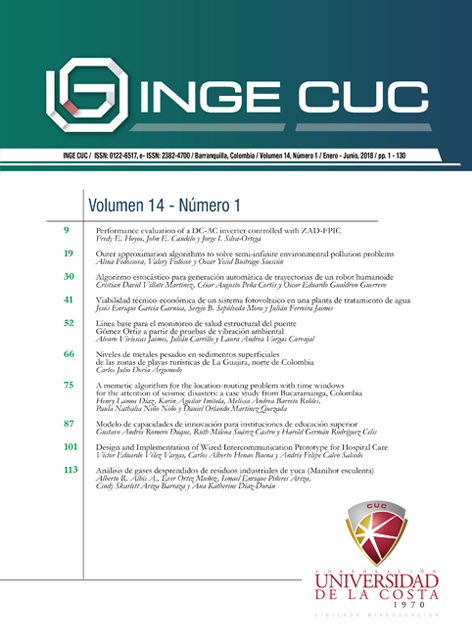Algoritmo estocástico para la generación automática de trayectorias de un robot humanoide
DOI:
https://doi.org/10.17981/ingecuc.14.1.2018.03Palabras clave:
Robots humanoides, planificación de trayectorias, robots autónomosResumen
Introducción: La incorporación de sistemas de aprendizaje autónomos en la robótica permitirá la resolución de una gran cantidad de problemas. Uno de ellos es la marcha autónoma para el caso de los robots humanoides debido a la complejidad que tiene por la gran cantidad de variables que influyen en este proceso.
Objetivo: Desarrollar algoritmos que generen marchas autónomas en un robot humanoide con varios grados de libertad.
Metodología: El estudio inicia con el desarrollo de algoritmos estocásticos con pocas dimensiones; luego, se extiende a situaciones n-dimensionales. Posteriormente, se realizan pruebas en simulación, y, por último, las pruebas experimentales.
Resultados: Se generó un algoritmo basado en el modelo físico del robot para crear las trayectorias de marcha estocásticamente.Se implementó un simulador que contempla las restricciones cinemáticas incluyendo colisiones para verificar los resultados. Adicionalmente, se realizaron cien pruebas experimentales donde se verificó el correcto funcionamiento de las trayectorias.
Conclusiones: Se pudo corroborar que es posible crear un algoritmo estocástico que mezcla reglas determinantes y aleatorias para generar marchas automáticamente en robots humanoides, extendiendo conceptos generados en espacios bidimensionales y tridimensionales a coordenadas articulares n-dimensionales.
Descargas
Citas
[2] G. Wiedebach et al., “Walking on partial footholds including line contacts with the humanoid robot atlas,” in IEEE-RAS International Conference on Humanoid Robots, pp. 1312–1319, 2016. DOI: 10.1109/HUMANOIDS.2016.7803439 URL: https://ieeexplore.ieee.org/document/7803439/
[3] B. Ding, A. Plummer y P. Iravani, “Investigating Balancing Control of a Standing Bipedal Robot With Point Foot Contact,” IFAC-PapersOnLine, vol. 49, no. 21, pp. 403–408, 2016. DOI: http://dx.doi.org/10.1016/j.ifacol.2016.10.587
[4] E. ; Ackerman y E. Guizzo, “Its Wheel-Leg Robot: ‘Best of Both Worlds,’” IEEE Spectrum, 2017. [En línea]. Disponible en: https://spectrum.ieee.org/automaton/robotics/humanoids/boston-dynamics-handle-robot. [Accessed: 20-Jul-2017] URL: https://spectrum.ieee.org/automaton/robotics/humanoids/
boston-dynamics-handle-robot
[5] Y. Hosoda, S. Egawa, J. Tamamoto, K. Yamamoto, R. Nakamura y M. Togami, “Basic design of human-symbiotic robot EMIEW,” in IEEE International Conference on Intelligent Robots and Systems, no. c, pp. 5079–5084, 2006. DOI: 10.1109/IROS.2006.282596. URL: http://ieeexplore.ieee.org/document/4059227/
[6] B. Henze, A. Dietrich y C. Ott, “An Approach to Combine Balancing with Hierarchical Whole-Body Control for Legged Humanoid Robots,” IEEE Robotics and Automation Letters, vol. 1, no. 2, pp. 700–707, 2016. DOI: 10.1109/LRA.2015.2512933. URL: http://ieeexplore.ieee.org/document/7368116/
[7] Y. Liu, P. M. Wensing, J. P. Schmiedeler y D. E. Orin, “Terrain-Blind Humanoid Walking Based on a 3-D Actuated Dual-SLIP Model,” IEEE Robotics and Automation Letters, vol. 1, no. 2, pp. 1073–1080, 2016. DOI: 10.1109/LRA.2016.2530160. URL: http://ieeexplore.ieee.org/document/7407320/
[8] M. W. Clearfield, “Learning to walk changes infants’ social interactions,” Infant Behavior and Development, vol. 34, no. 1, pp. 15–25, 2011. DOI: 10.1016/j.infbeh.2010.04.008. URL: http://dx.doi.org/10.1016/j.infbeh.2010.04.008
[9] E. P. Shaw et al., “Measurement of attentional reserve and mental effort for cognitive workload assessment under various task demands during dual-task walking,” Biological Psychology, vol. 134, no. January, pp. 39–51, 2018. DOI: 10.1016/j.biopsycho.2018.01.009. URL: http://linkinghub.elsevier.com/retrieve/pii/S0301051118300413
[10] K. B. Lee, H. Myung y J. H. Kim, “Online multiobjective evolutionary approach for navigation of humanoid robots,” IEEE Transactions on Industrial Electronics, vol. 62, no. 9, pp. 5586–5597, 2015. DOI: 10.1109/TIE.2015.2405901. URL: http://ieeexplore.ieee.org/document/7047860/
[11] D. A. López, J. E. Hernández y C. A. Peña Cortes, “Advances in the control of bipedal platforms using
the system,” Revista Colombiana de Tecnologías de Avanzada, vol. 2, pp. 117–124, 2013. DOI: https://doi.
org/10.24054/16927257.v22.n22.2013.419. URL: http://revistas.unipamplona.edu.co/ojs_viceinves/index.php/RCTA/article/view/419
[12] K. Teachasrisaksakul, Z. Q. Zhang, G. Z. Yang y B. Lo, “Imitation of dynamic walking with bsn for Humanoid robot,” IEEE Journal of Biomedical and Health Informatics, vol. 19, no. 3, pp. 794–802, 2015. DOI: 10.1109/JBHI.2015.2425221. URL: http://ieeexplore.ieee.org/document/7096914/
[13] A. Barrientos, L. Peñin, C. Balager y R. Aracil, Fundamentos de Robótica, 2nd ed. Madrid: McGraw-Hill, 2007.
[14] E. Luhta, “Walk Cycles,” in How to Cheat in Maya 2010, Boston: Focal Press, pp. 177–221, 2010. DOI: 10.1016/B978-0-240-81188-8.50008-4. URL: http://linkinghub.elsevier.com/retrieve/pii/B9780240811888500084
[15] K. H. Koch, K. Mombaur y P. Soueres, “Optimizationbased walking generation for humanoid robot,” in IFAC Proceedings Volumes (IFAC-PapersOnline), vol. 45, no. 22, pp. 498–504, 2012. DOI: 10.3182/20120905-3-HR-2030.00189. URL: http://dx.doi.org/10.3182/20120905-3-HR-2030.00189
[16] J. V. Nunez, A. Briseno, D. A. Rodriguez, J. M. Ibarra y V. M. Rodriguez, “Explicit Analytic Solution for Inverse Kinematics of Bioloid Humanoid Robot,” in 2012 Brazilian Robotics Symposium and Latin American Robotics Symposium, pp. 33–38, 2012. DOI: 10.1109/SBR-LARS.2012.62. URL: http://ieeexplore.ieee.org/document/6363315/
[17] P. Wawrzynski, J. Mozaryn y J. Klimaszewski, “Robust estimation of walking robots velocity and tilt using proprioceptive sensors data fusion,” Robotics and Autonomous Systems, vol. 66, pp. 44–54, 2015. DOI: 10.1016/j.robot.2014.12.012. URL: http://dx.doi.org/10.1016/j.robot.2014.12.012
[18] L. W. Tsai, Robot Analysis: The Mechanics of Serial and Parallel Manipulators. Maryland, USA: Wiley, 1999. URL: http://www.wiley.com/WileyCDA/WileyTitle/productCd-0471325937.html
[19] J. Zhao, Z. Feng, F. Chu y N. Ma, “A Brief Introduction to Screw Theory,” in Advanced Theory of Constraint and Motion Analysis for Robot Mechanisms, pp. 29–79, 2014. DOI: 10.1016/B978-0-12-420162-0.00002-3. URL: http://www.sciencedirect.com/science/article/pii/B9780124201620000023
Descargas
Publicado
Cómo citar
Número
Sección
Licencia
Los artículos publicados son de exclusiva responsabilidad de sus autores y no reflejan necesariamente las opiniones del comité editorial.
La Revista INGE CUC respeta los derechos morales de sus autores, los cuales ceden al comité editorial los derechos patrimoniales del material publicado. A su vez, los autores informan que el presente trabajo es inédito y no ha sido publicado anteriormente.
Todos los artículos están bajo una Licencia Creative Commons Atribución-NoComercial-SinDerivadas 4.0 Internacional.



 English
English
 Español (España)
Español (España)























